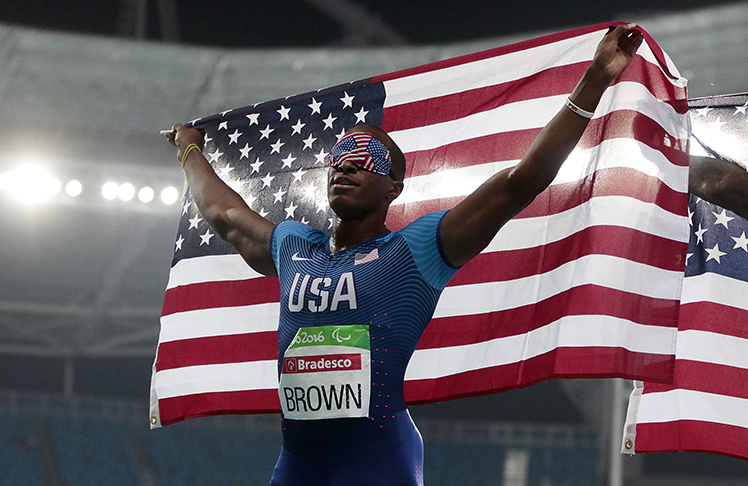
By George Ramsay, CNN Video produced by Stefania Dall’Armi
(CNN) — It was in the stands of Beijing’s Bird’s Nest stadium that David Brown’s dreams of a career in track and field started to take hold.
Brown, who has been blind since the age of 13, remembers taking in the “spots and colors” of the Paralympic Games in Beijing as his friends dictated what was happening down on the track.
“I’m like: ‘Hey, some of these guys have the same sight that I do, it sounds like,'” Brown recalls to CNN Sport. “They’re down there running and they’re doing this … and I’m like: ‘Yo, this is possible. I can do this.'”
That was in 2008, but fast-forward 13 years and Brown is now preparing to defend his crown in the 100-meter T11 event at the Paralympics in Tokyo.
Aside from winning a Paralympic gold medal in 2016, the 28-year-old Brown also lays claim to being the first totally blind athlete to run under 11 seconds in the 100m with his classification record of 10.92 seconds.
But the transition from fan in the stands to record-breaking athlete didn’t happen overnight. Growing up, Brown turned his hand to many sports — basketball, wrestling, goalball (a team sport designed specifically for visually-impaired athletes) and volleyball to name a few — before settling on the track.
He raced in 600 and 60-meter events with the track team at the Missouri School for the Blind in St. Louis — gripping a clothesline-like wire that ran alongside the track for assistance — and from there gradually transitioned to running with a guide.
“I was in very big denial of my sight, which is one thing, so there were times when I would run and I didn’t run with a guide because I thought I could see,” Brown says. He was diagnosed with Kawasaki disease at 15 months old, which resulted in glaucoma and ultimately losing his sight years later.
Brown continues: “I was able to see well enough to not necessarily stay in my lanes when I was racing, but I was able to see well enough to stay on the track. So that’s how I got through a lot of things for a while. I didn’t start running with a guide officially until I was 17 years old.”
‘Like a three-legged race’
Running with a guide is a difficult art to master. Athletes in Brown’s T11 category — which is those with “very low visual acuity and/or no light perception” — run on a tether; the guide’s role is to make sure competitors stay in lane and know how the race is progressing.
“We’re running like a three-legged race,” Brown explains.
“They’re having to adapt to me and my running style and to pretty much how fast and how slow I’m going — my body language.
“They have to be one, in great condition; two, very fast; three, to be able to synchronize their steps with how fast or how slow I’m moving my arms and my legs. Making those adaptations is very vital.”
“Untethered,” a film released on August 3 and produced by Swiss sportswear brand On, tells the story of Brown and his relationship with guide runner Jerome Avery.
Avery, a top sprinter in his own right, finished outside the Olympic qualifying spots at the US track and field trials in 2000 and 2004. He has been a guide runner with US Paralympics since 2004.
An injury to Avery in the buildup to this year’s Games means he and Brown won’t run together Tokyo — a big challenge for Brown as he looks to defend his Rio gold, given he and Avery have competed together for seven years.
“It will be different, it will be a big shift and a change,” Brown said of the prospect of competing with a new guide. “But I’m looking forward to seeing what happens, honestly.”
‘Everything has a tempo’
Referenced in “Untethered” is Brown’s love for music. He says he has an eclectic taste — including classical, country, gospel, jazz and reggae — and plays drums and piano at his local church. In the film, he meets Tariq Trotter, the rap artist better known as Black Thought.
To an extent, it’s an interest that benefits Brown’s athletic career and the practice of running with a guide.
“Everything has a tempo, you know, and there’s a certain beat that we will, I guess, go to in the sense of running,” he says.
“Of course, you see it in the track room. They say, ‘Oh, he’s taken 234 steps a minute,’ or something like that. You could think of it like beats per minute … it can help get on the same page as far as synchronizing goes.”
Brown adds, however, that using a tether is the best way for a runner and guide to synchronize.
“Say I’m off a step and they’re on … you won’t feel that or you won’t even notice that if you don’t have the tether on,” he says. “The more you have the tether on, the more that you do with the tether, whether it be a slow tempo or a fast tempo, the better.”
Lowering records
The track in Tokyo’s Olympic Stadium is a favorable one for sprinters, yielding fast times during the Olympic Games. Brown’s world record could be threatened in the coming weeks as the Paralympics get underway, although he remains unfazed by the idea of one of his rivals beating his time.
“If somebody breaks my world record … that means our classification is getting faster and that’s the furthering of the sport,” he says. “And that’s what it’s all about at the end of the day. I was just the catalyst for all this.”
Having changed guides in the buildup to the Paralympics, Brown has tempered expectations going into the Games.
But that’s not to say that fast times — and more world records — aren’t on his mind further down the line.
“We’re training towards the future,” says Brown. “We’re already looking at Paris.
“Our training has not been where I guess you could say technically Games training would be, so I don’t know about Tokyo, necessarily, but next year or the following year after that — that’s where I’m saying: ‘Hey, look out because it’s going to get pretty lethal over on this end.’ We have a lot of great guides that we are training up.
“If everything keeps going in the direction that it’s going, the possibilities are endless on how fast we can go and how low we can lower this thing.”
The-CNN-Wire
™ & © 2021 Cable News Network, Inc., a WarnerMedia Company. All rights reserved.















